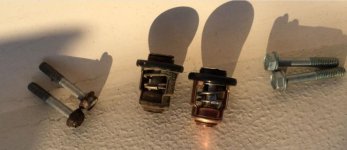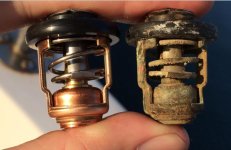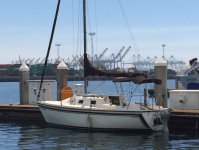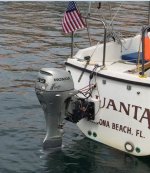Hello everyone - I finally have an update.
First, to jgmo's question - I replaced the impeller and the gasket. I did not replace the liner. I have a spare key now because I thought I would drop it in the water, but I didn't.
Ok. So I've had the boat out a few times since my last post. Once I had the same issue where it worked fine as I left the slip, went sailing, and then had issues coming in. After several tries the water began flowing through the indicator. Once, it worked with no issues period. Then last weekend, I had issues coming back in once again. That time I noticed that no water was coming out (I was running under load for maybe 20 seconds) and I had to shut down as I simultaneously noticed a lack of water flow and the console overheat alarm sounded. I had to sail to a nearby dock (that was interesting), and figure it out. I tried the canned air up the pisser trick and the water flowed right away after that. I made it back into my slip.
Today, finally, I was able to go down and swap out the thermostat. I will add a couple of pictures I took. Surprisingly, the bolts were not corroded as I feared they were (though I was armed with PB Blaster just in case). I had to put vice grips to the lower bolt as the head was far too corroded to get a socket or spanner on it.
Anyway after the swap, I fired up the engine and let it idle. It flowed water immediately, but overheated (as per the console overheat alarm) after about 2.5 minutes. I immediately shut it down, let it cool down a bit, and restarted it but this time, held the fast idle up a little bit to increase the RPMs. You could see an increase in the amount of water flowing from the pisser. I got bored after about four minutes of this (no more overheating) and disconnected and ran the gas out of the lines. Total run time the second try, almost 9 minutes without overheating (touched places on the head with my fingers as well - intake side was warm but not hot, the exhaust side was certainly hot but not fry-my-skin hot).
Overall the articulating outboard bracket is, IMO, mounted a bit too high as I have trouble keeping the propeller submerged in any kind of semi-significant seaway/wave action. That said, the shop manual says that the XL shaft can take a 27" transom mount; I measured with the mount in the down position and I am only 22" from the water to the top off the mount.
I wonder if these things are conspiring to cause my overheating, and possibly circulation problems:
1) The motor is mounted too high, thus the impeller is not in dense enough water to create enough pressure to break/overcome some bubble in the water jacket;
2) The idle speed is set too low (I don't know of a way to measure it BTW)
3) There is some partial blockage in the water jacket.
I can easily increase the idle speed but I'm worried that I will end up cranking it too high, and will cause damage to the pinion gears when shifting from neutral into gear. I can (and actually, probably will) re-mount the articulating bracket, so that I can get the motor down farther into the water. I suppose I can try that and see if it will make a difference (I suspect that it will). Finally, I can pay some so-called outboard expert several hundred dollars to try to "fix" it, though I am unsure how one would do it accurately without some surgical borescope or a CAT scan of the head and water jacket pathways.

EDIT: I always do a freshwater flush using the adapter that screws into the head near the thermostat housing. Lately I've been flushing with Salt Away using the in-line chamber for the Salt Away.
Anyway, thanks to this community for the ideas and suggestions. Hopefully I can attach these pictures.
Thermo - old and new:


Motor mounting height above water:





